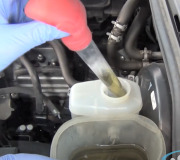First of all, while bleeding, did you do that with a helper and was the brake pedal pushed all the way to the floor? If so, there are two things to be aware of. The first is crud and corrosion build up in the lower halves of the bores in the master cylinder where the pistons do not normally travel. Running the pedal to the floor, whether bleeding improperly or when surprised by a sudden leak, runs the rubber lip seals over that crud and can rip them. That can result in a slowly-sinking pedal that often does not show up until two or three days later. It can also cause no fluid to flow to one front brake and the opposite rear brake. To avoid this heartache, I only use gravity-bleeding with no helper.
https://www.2carpros.com/articles/how-to-bleed-or-flush-a-car-brake-system
When only replacing calipers or rubber flex hoses, you do not have to bleed the entire system, although replacing the brake fluid periodically is recommended, to get the moisture out that it absorbed over time. Do not let the reservoir run empty, then just wait for the fluid to show up at the bleeder screw. Close that one, then wait for the next one to start flowing. When all bleeders are closed, "irritate" the brake pedal a little by hand, then open each bleeder once more just long enough to burp out the few tiny bubbles that washed into the caliper. You will need to pump the brake pedal to run the pistons out of the calipers until the pads contact the rotors. Be sure to never push the pedal over half way to the floor. The exception is its okay to push the pedal to the floor if the master cylinder is less than about a year old, except on GM vehicles, because.
The second important thing to be aware of only applies to GM front-wheel-drive cars. Most fwd cars use a "split-diagonal" brake hydraulic system. Instead of a front and a rear system like we have had since the 1960's, the left front and right rear are on the same hydraulic circuit. GM master cylinders have a valve that trips to block off two ports when one circuit does not build the same pressure as the other one. That happens when one circuit has a leak but it will also occur when you stroke the pedal to push the pistons out of the caliper housings. One piston will naturally come out first and when the pads contact the rotor, that side will start to build pressure. Since the other piston has not moved as far yet, no pressure will build and that valve will trip. From that point on, no matter how hard you press the brake pedal, no fluid will come out of that caliper and the opposite rear wheel cylinder. The service manual says that can be avoided by pedal-bleeding the wheels in a specific sequence, but they lied. That valve will trip if any wheel builds pressure while any wheel does not.
Once that happens, many people identify the master cylinder as the reason they cannot get brake fluid from two wheels and they replace it, then run into the same problem when bleeding the new one. This can happen even when not bleeding anything. Just pumping the pistons out after replacing the front pads can cause this problem. The only way I have ever found to reset that valve is go to one of the wheels that is not flowing fluid and give a very short, quick burst of compressed air through the opened bleeder screw, then let it gravity-bleed.
Some owners do not even notice when that valve has tripped. Suspension geometry and alignment angles have been modified on front-wheel-drive cars so there will be no brake pull when one side is not applying. On Chrysler's you will never see the slightest hint of a pull. On most GM's, all you will see is a slight wiggle of the steering wheel as the brake pedal is being applied. A fairly common complaint on GM's is those new front brake pads wore out too quickly on one side and the other side looks like brand new. That is because the one side is never applying and one side does all the stopping. Some people don't ask for help until they have gone through two or three pairs of pads, then they figure out something is wrong. All this can be avoided by never pushing the brake pedal more than half-way down to the floor.
Friday, December 15th, 2017 AT 1:24 PM


